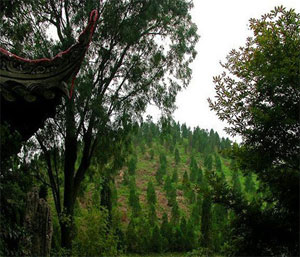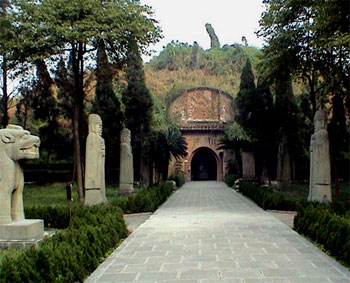The Wangjian tomb is 15 meters high and 80 meters in diameter. Fourteen huge double vaults and red-colored sandstone walls support the burial chambers. Gray bricks are laid against the sandstone walls. Bricks are placed upon bricks to form a thick wall to further protect the tomb. On the surface of the brick protectors are piles of soil rammed down that gives the shape of the tomb.
In North China, most of the mausoleums are built underground, including the Ming Tomb. You may wonder why the Tomb of Wang Jian is built above ground. Chengdu is located in the Sichuan Basin surrounded by hills and mountains. Its terrain is very low. People often say: “ You will get water if you dig a hole three feet deep beneath the ground in Chengdu.” The ancient builders were afraid that the tomb might have been flooded if they had placed it underground.

Tomb of Wangjian.
Wangjiang Tomb Chambers
Well, the tomb contains three chambers: the fore-chamber, the center-chamber and the innermost-chamber. The fore-chamber serves as a path or a corridor. It leads to the center-chamber where an ornamental coffin platform reposes. Twelve carved men of unusual strength and a relief of 24 musicians and dancers are on the east, west and south sides.
The innermost-chamber contains a life-sized statue of Wang Jian in a relaxed sitting position. Originally, each chamber had its own individual doors to separate chambers. Now only the fore-chamber has a wooden door. It’s a copy to display the shape of the original huge doors. Some incomplete paintings still remain on the top of the third vault. They are decorative patterns made with red and blue mineral pigments. These patterns are over 1,000 years old based on a historical document.
There are four carved Chinese characters on the ground of the fore-chamber. They are called Dongchuan (东川) and Jingshui (金水). These Chinese characters are the names of places in the Chengdu areas. They tell us that most of the stone materials for the tomb construction were moved form these places.

When the first group of archaeologists came into the tomb, they discovered that the tomb had been robbed. It might have happened soon after the Former Shu State was defeated. The ancient grave robbers came into the tomb through the upper-left of the tomb gate. The archaeologists found the coffin platform in a state of disorder and the inside was in ruins.
The archaeologists guessed that the ancient robbers were responsible for the mess. On the platform was a large amount of mercury. In ancient times mercury was used as a preservative for corpses, but the archaeologists didn’t find any remains of the dead. It's believed that the dead emperor had considerable amount of valuable jewelry on his corpse and in his burial costume; the robbers probably pulled the corpse out of the chamber in order to steal the valuables. However, the archaeologists still found silver and jade wares left inside the chamber.
In terms of historical culture, the most valuable relics inside the tomb are the chambers and the carved stones. They remain intact. The coffin platform in the center chamber is made of red sandstone and placed a bit back of the center. A jade plate is on the platform. On the plate was a three-tiered wooden terrace. The coffin was placed on the top. The coffin and terrace deteriorated into soil long ago. There were still some remaining iron hoops and nails that were used as the coffin’s ornaments.
On top of the platform, dragons are carved in forceful gestures playing a pearl among musicians, lotus flowers and mythical birds. Originally, the musicians were painted red in coats and apricot yellow in skirts; the dragons were gilded with a thin layer of gold; the whole inner chambers were also painted. |